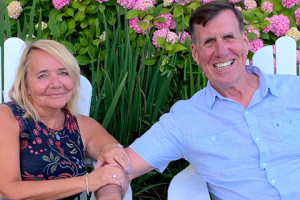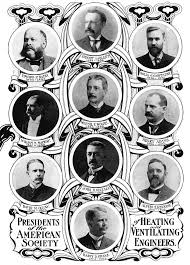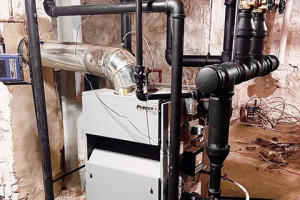
Hello, old friend. I’m writing today to say thanks, and to say farewell. This will be my last column.

I was in Manhattan for a meeting and had some extra time on my hands, so I strolled over to West 31th Street to where a bunch of guys had gotten together for a meeting on September 10, 1894. This group would become ASHRAE and I just wanted to see if I could feel the leftover energy.
I stood across the street and listened to the sounds of the city. People walked by and ignored me. It's easy to be invisible in New York City, and easier still to imagine.
Hugh J. Barron was the sparkplug for that first meeting. He was a steamfitter and had been a member of the Master Steamfitters Organization until the year before. He left in a huff because those in charge of that group decided to cut short the talks given at their regular meetings. They told David Nesbit, who had traveled from England to explain English heating to American steamfitters, that they would give him 10 minutes. That's it.
Mr. Barron took Mr. Nesbit by the arm and they left to form a new association they would call the American Society of Heating and Ventilating Engineers, which would grow like corn and eventually become the American Society of Heating, Refrigeration, and Air-Conditioning Engineers.
The new group met for that first time over there across the street. They borrowed the offices of the Mechanical Engineers Association, which was to become ASME. At the time of that first meeting, the association had 75 members; 45 were in attendance. I marvel at the list of names. It reads like a Who's Who of the fin de siècle heating industry. They went on to discuss things of interest, and they took their sweet time in doing so.
I'm a member of a few associations, although I've never been smart enough for ASHRAE. At one of my meetings, I listened to the board discuss who should be allowed to join that association, and serve on the board. Who should run the thing, and should they raise the dues? They went back and forth on these issues, and since most of the members were contractors, the biggest issue was whether they should allow manufacturers to take a greater role, specifically to hold office.
But what if those manufacturers tried to take over? What if they gained too much of a voice, too much power? What if they tried to sell someone something?
Someone suggested that associate members (specifically, the manufacturers and other non-contractor members, such as me) should be allowed to hold office. "We need new ideas," he said, but that caused uproar from other board members. "We can't give them any power!" one insisted. "They'll try to take over and ruin everything."
"But they're our friends. They care about the association."
"Doesn't matter! We can't let them take charge. It's ours."
"But what if they pull out?"
"They wouldn't dare!"
That last declaration had a few members mentioning that the group took money by way of large dues payments from those manufacturers, and that they had supported the group for years by their participation in the tradeshow, so perhaps they should be allowed to hold office, and to serve the association.
"No way!" they shouted. And so they tabled the idea and it festered like an open wound.
I sat in the audience feeling very much Us vs. Them. I was neither a contractor nor a manufacturer, but I had been a productive (at least I thought so) member of this group for decades, and membership was shrinking. So why were we making good people who really cared and wanted to help feel like outsiders?
I shared these thoughts afterward (at the bar, of course) with some of the board members. I told them that they had made me feel a bit unloved. They told me I was being ridiculous. They got angry. I got quiet.
I know a bit about the early days of the American Society of Heating and Ventilating Engineers because they kept magnificent records. A stenographer took down every word said at all of those early meetings. The technical papers submitted dance with life and are fun to read. If you've ever wondered how they first Determined the Heating Power of a Heating System, or the Testing of Steam Radiators, or if you ever wanted to sit in on A Short Talk on the Construction of Hot Water Radiators, I know just where you can go. And after the presentation of each paper, the members in attendance spoke up, offering their thoughts and comments. These people were not shy.
Mr. Barron: "There is one feature of this paper that has no bearing on what has been discussed, but it strikes me very forcibly, and that is the prejudice or superstition shown here with respect to certain systems, if the gentleman will allow me to use the words prejudice and superstition. I am very superstitious myself and therefore I like to combat it."
So proclaimed the Angry Irishman. From there, the conversation gets even more heated. They dip into the quality of the metal that was going into radiators at the time, and the internal shape of those radiators. They spend a lot of time talking about the at-the-time, undefined concept of we today call pick-up factor, that part of boiler sizing that takes into account the amount of water that's in a system, as well as the size of the pipes.
In 1899, at their last meeting of the century, The Carbon Club, which will eventually become the Hydronics Institute, responded by adopting a uniform pick-up factor of 1.56 for both steam- and hot-water systems. ASHVE influenced The Carbon Club. They learned from each other.
All of this and much more came out of the often heated arguments that took place so long ago at those association meetings. I read the words today and can imagine it all. They would fit in well at the association meetings of today. People really don't change.
Another speaks: "In our deliberations yesterday, there was a little tendency to belittle the architects. Gentlemen, this is wrong. You would not be here if not for the architects."
See what I mean?
A year later, at their second meeting, they had grown to 102 members, 57 of whom had shown up. These thoughts arrive:
"It will be noticed by a study of a list of members that very few manufacturers of heating equipment have been admitted to membership. The society was started as a distinctly engineering society, and it seemed necessary to rigidly cut loose from all commercial influences in order to clearly establish the objects and desires of the association."
But then that thought shifts because the engineers realize that the manufacturers have the contacts with the consumers, and that's resulting in "data and coefficients, which, if placed before the society, would be of great value in the solution of engineering questions." For sure.
They then note "the manufacturer could add much information of value to the engineer relating to the preparation of the various articles required in this great art."
Yes, how about if we all try to work together? And then they state the obvious: "The manufacturer himself is an engineer by virtue of his occupation."
And few of these men were engineers by degree. They were engineers in the Thomas Edison sense, the Nicola Tesla sense. To be an engineer was to be someone who made things and solved mechanical problems. It was a worthy title.
So these passionate people, long dead, set the groundwork for what is to be AHSRAE, a worldwide association that surely gets things done. I smile when I read the minutes of those meetings held so long ago, and I think about the meetings I attend these days. Some of them involve folks who are trying to build small fiefdoms for themselves. They turn away people who want to help simply because those people don't arrive with the correct titles or status, which sure seems counterproductive to me.
So I'd like to make a motion: The next time you're in an association meeting where they're talking about keeping good people in check rather than finding ways to tap into the vibrant knowledge and experience of those people, and all for the betterment of that association, you should read this column aloud, and into the minutes.
Will you second the motion?

Hello, old friend. I’m writing today to say thanks, and to say farewell. This will be my last column.

My six-year-old grandboy, Brendan, was in the vestibule of the diner when the bubblegum machine caught his attention. It was one of those spiral models that appeared in t...

Subdural posed a question on The Wall at HeatingHelp.com in the Strictly Steam section, where some of the sharpest knives in the drawer post every day. The question was a...